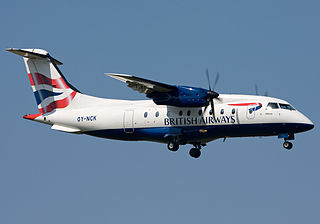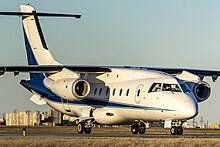
Dornier Flugzeugwerke was a German aircraft manufacturer founded in Friedrichshafen in 1914 by Claude Dornier. Over the course of its long lifespan, the company produced many designs for both the civil and military markets.

DASA was a German aerospace manufacturer.

Telluride Regional Airport is a public airport six miles west of Telluride, in San Miguel County, Colorado, United States. It is owned by the Telluride Regional Airport Authority. At an elevation of 9,078 feet above sea level, it was the highest commercial airport in North America with scheduled passenger flights when Great Lakes Airlines resumed scheduled passenger service in December 2016; however, those flights ceased in March 2018. In August 2018, commercial service returned with the introduction of Boutique Air, and the airport remains the highest airfield in the U.S. with scheduled passenger flights, and the second highest overall airfield in the US behind Leadville Airport. Denver Air Connection is currently the only airline flying scheduled passenger flights from Telluride with daily nonstop flights to Denver and Phoenix. Denver Air operates the Fairchild-Dornier 328JET into Telluride. The 328JET is one of the few regional jet airliners in service capable of operating at such high field elevations as TEX.

A regional airliner or a feeder liner is a small airliner that is designed to fly up to 100 passengers on short-haul flights, usually feeding larger carriers' airline hubs from small markets. This class of airliners is typically flown by the regional airlines that are either contracted by or subsidiaries of the larger airlines. Regional airliners are used for short trips between smaller towns or from a larger city to a smaller city. Feeder liner, commuter, and local service are all alternative terms for the same class of flight operations.

The Fokker F28 Fellowship is a twin-engined, short-range jet airliner designed and built by Dutch aircraft manufacturer Fokker.

The Fokker 100 is a regional jet that was produced by Fokker in the Netherlands. The Fokker 100 was based on the Fokker F28 with a fuselage stretched by 5.7 m (18.8 ft) to seat up to 109 passengers, up from 85. It is powered by two newer Rolls-Royce Tay turbofans, and it has an updated glass cockpit and a wider wing and tail for increased maximum weights.

The Saab 340 is a Swedish twin-engine turboprop aircraft designed and initially produced by Saab AB and Fairchild Aircraft. It is designed to seat 30-36 passengers and, as of July 2018, there were 240 operational aircraft used by 34 different operators.
AvCraft Technical Services was a Myrtle Beach, South Carolina U.S., based company that supplied maintenance and technical support services for owners/operators of Bombardier Dash 8, ATR 42, ATR 72 and Fairchild Dornier 328 turboprop and jet aircraft.
Skyway Airlines was an American ramp and aircraft ground handling services and catering company based in Oak Creek, Wisconsin. Until April 5, 2008, it operated as a regional airline and banner carrier exclusively for Midwest Express Airlines under the business name Midwest Connect, feeding Midwest's hub at General Mitchell International Airport with twelve 32-seat Fairchild-Dornier 328JET regional jet aircraft, and four 19-seat Beechcraft 1900 commuter turboprops. Skyway Airlines, along with its parent corporation, Midwest Air Group, has since ceased operations.
The Fairchild Dornier 728/928 family was a series of jet-powered regional airliners that was being developed by German-American aviation conglomerate Fairchild Dornier.

The Fokker 50 is a turboprop-powered airliner manufactured and supported by Dutch aircraft manufacturer Fokker. It was designed as an improved version of the successful Fokker F27 Friendship. The Fokker 60 is a stretched freighter version of the Fokker 50.
SUN-AIR of Scandinavia A/S, usually shortened to SUN-AIR, is a Danish regional airline headquartered in Billund, with its main base at Billund Airport. It operates scheduled services as a franchise of British Airways using their name and corporate design as British Airways - operated by SUN-AIR of Scandinavia A/S. The airline also offers charter flights, air taxi services, specialist aerial work and aircraft brokerage services.
Augsburg Airways was a German regional airline. A member of Team Lufthansa and its successor Lufthansa Regional, it operated feeder services at Munich Airport on behalf of Lufthansa.

The Dornier 328 is a turboprop-powered commuter airliner. Initially produced by Dornier Luftfahrt GmbH, the firm was acquired in 1996 by Fairchild Aircraft. The resulting firm, named Fairchild-Dornier, manufactured the 328 family in Oberpfaffenhofen, Germany, conducted sales from San Antonio, Texas, United States, and supported the product line from both locations. A jet-powered version of the aircraft, the Fairchild Dornier 328JET, was also produced.

The Honeywell TPE331 is a turboprop engine. It was designed in the 1950s by Garrett AiResearch, and produced since 1999 by successor Honeywell Aerospace. The engine's power output ranges from 575 to 1,650 shaft horsepower.

A regional jet (RJ) is a jet-powered regional airliner with fewer than 100 seats. The first one was the Sud-Aviation Caravelle in 1959, followed by the widespread Yakovlev Yak-40, Fokker F-28, and BAe 146. The 1990s saw the emergence of the most widespread Canadair Regional Jet and its Embraer Regional Jet counterpart, then the larger Embraer E-Jet and multiple competing projects. In the US, they are limited in size by scope clauses.

The Fairchild Dornier 428JET was a program undertaken by American company Fairchild Dornier to develop a 44-seat regional jet aircraft. The program was part of a broader attempt by the company to develop a family of regional jets, comprising the 328JET, 428JET, and the 728 series. This family of aircraft was designed to compete with the Bombardier CRJ and Embraer ERJ/Embraer E-Jets families. The aircraft was announced on May 19, 1998. It was cancelled in August 2000.

Tianjin Airlines is a Chinese airline headquartered in Tianjin Binhai International Airport passenger terminal building, Dongli District, Tianjin, operating domestic scheduled passenger and cargo flights out of Tianjin Binhai International Airport.

Denver Air Connection is a subsidiary of Key Lime Air providing both charter and scheduled passenger air service.
Deutsche Regional Aircraft GmbH is a German aircraft manufacturer based in Oberpfaffenhofen, Germany.


















